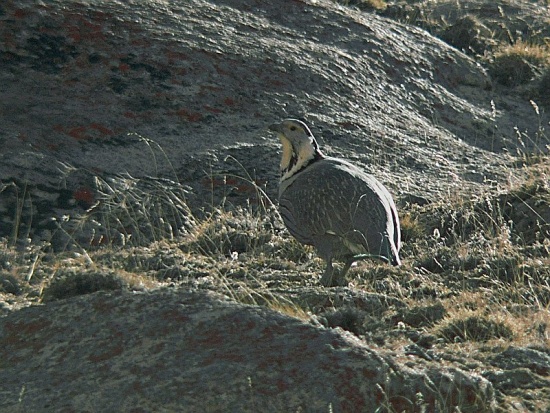- Tetraogallus himalayensis
Identification
54–72 cm (21¼-28½ in)
- Grey, brown, white and black general plumage
- Pale has horizontal blackish streaking
- White throat
- Thin brown collar (unique to the genus)
Distribution
Native to the Himalayas. A small (several hundred) population was introduced into the Ruby Mountains of ne Nevada, USA, and is apparently thriving.
Taxonomy
Subspecies
Five subspecies are recognized:[1]
- T. h. sewerzowi - Tien Shan mountain range to north-western China
- T. h. incognitus - South Tajikistan and northern Afghanistan
- T. h. himalayensis - East Afgahnistan to north-western India and Nepal
- T. h. grombezewskii - Kunlun mountain range in West China to northern Tibet and southern Xinjiang
- T. h. koslowi - West China in the Nam Shan and Ching Hai Ku mountain ranges
The subspecies T. h. koslowi is relatively distinct and has in the past been viewed as a full species.
Habitat
In the Himalaya, it breeds at altitudes from 3600-5100 m on bare stony slopes of mountains.
Behaviour
Diet
Small flocks fly downhill in the morning, foraging systematically uphill as the day progresses. Diet bulbous roots, tubers, berries and grass.
Breeding
They are monogamous and territorial. They nests in a depression amongst grass tufts. Their clutch typically contains 5-10 eggs, which are incubated only by the female. Both parents raise the young.
References
- Clements, J. F., T. S. Schulenberg, M. J. Iliff, D. Roberson, T. A. Fredericks, B. L. Sullivan, and C. L. Wood. 2018. The eBird/Clements checklist of birds of the world: v2018. Downloaded from http://www.birds.cornell.edu/clementschecklist/download/
- Handbook of the Birds of the World Alive (retrieved May 2019)
- Birdforum thread discussing the taxonomy of Himalayan Snowcock




